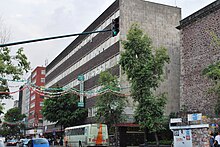Hospital de Jesús Nazareno
| Hospital and church de Jesús Nazareno | |
|---|---|

Modernist façade of the Hospital
|
|
| Geography | |
| Location |
Historic Mexico City Centro, Mexico City, México, D. F., Mexico |
| Organisation | |
| Affiliated university | Independent |
| History | |
| Founded | 1524 |
| Links | |
| Website | http://www.hospitaldejesus.com.mx/ |
| Other links | |
The Church and Hospital of Jesús Nazareno buildings are located in the Historic center of Mexico City, in México, D. F., Mexico. The hospital is still in operation, housed in a Modernist building, located in front of the original one, and beside the former church. Both historic buildings and their courtyards are 17th century Spanish colonial era architecture.
The Church and Hospital are supposedly located at the spot where Hernán Cortés and Moctezuma II met for the first time in 1519, which was then the beginning of the causeway leading to Iztapalapa. Cortés ordered the hospital built to tend to Aztec soldiers wounded fighting with the Spanish.
In his last will, Cortés clearly states that he wanted the hospital to be built for the sons of the Aztec warriors who had perished in battle during the Conquest of Tenochtitlan. This was not an institution for wounded Spanish soldiers. It was built many years after the Spanish conquest of the Aztec empire.
In 1646, the hospital was the site of the first autopsies performed on the American continent, performed to teach anatomy to medical students of the Royal and Pontifical University of Mexico. In 1715, the hospital published the Regia Academia Mariana Practica Medica to promote more professional practices in the field of medicine in New Spain. The building today continues to function as a hospital.
The complex consists of a church and the hospital divided into four sections. The original hospital building is hidden by a Modernist façade, but the façade of the adjacent church is original. After passing the main entrance, one comes to a two-story colonial courtyard filled with plants and a fountain in the center. The hospital courtyard was originally decorated with Tuscan columns, but have since been replaced by equally austere ones. The original staircase remains, which contains a bust of Cortés and past this staircase is a second courtyard. One courtyard was for men and the other for women. The best-known portrait of Cortés can still be seen here. On the frieze of the upper corridors of the south side have a series of small and grotesque faces, which are popularly and mistakenly considered to be those of Cortés’ relatives.
...
Wikipedia
